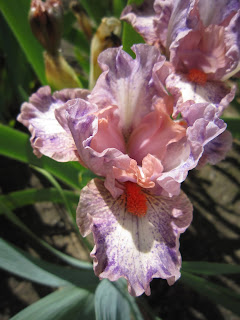by Heather Haley and Alleah Barnes Haley
Irises growing beside Heather's driveway
Greetings from the Piedmont, a plateau in the eastern United States between the Atlantic Ocean and the Appalachian Mountains. This is our first post for the World of Irises blog. As a mother-daughter team, we joyfully spent many hours at Heather’s kitchen table working on the booklet for the 2019 national convention and are pleased to serve the American Iris Society in a new way.
Keren, Heather, and Susan with their mother Alleah Haley at a national convention
Aitken’s Salmon Creek Garden, Portland, Oregon
Members of our family have grown irises from one coast of the United States to the other since the 1940s. Although climate and soil characteristics differ from one location to the next, one piece of advice is timeless and universal: bearded irises prefer full sun and well-drained soil.
As a child in New Mexico, Alleah learned this the hard way. At the age of nine, she was given the area along a shaded driveway where she planted bearded iris rhizomes from her mother Gertie. The irises grew poorly. Alleah’s early experiment taught her a basic principle of iris culture: plant bearded irises in full sun with well-drained soil. Three years later she used a sunny spot and planted gifts from her mother’s iris friends: a new introduction from hybridizer Georgia Hinkle and two advanced seedlings from hybridizer Steve Varner. They grew well!
As an adult in California, Alleah provided optimal growing conditions for irises using raised beds with full sun. Alleah constructed wooden beds over wire to keep gophers from eating her irises, and filled the beds with purchased sandy loam soil. Although the surface of raised beds is flat, a combination of soil type and elevated planting ensures that irises are well-drained.

Raised beds at Alleah's home in California
From a young age, Alleah’s youngest daughter Heather enjoyed helping her mother in the garden. For about a decade, mother and daughter bonded while weeding, digging, and replanting mom’s irises. Heather learned a lot about growing irises while she lived on the West Coast. However, moving to the East Coast gave Heather an opportunity to learn an important lesson for herself. Bearded irises grow best when planted in well-drained soil.
Source: National Resources Conservation Service, USDA
As an adult, Heather settled in North Carolina’s Piedmont region and planted irises of her own for the first time. With help from her husband Chris, Heather established iris beds along the driveway of their first home. Although the area was in full sun, the ground was unlike anything the two California natives had seen before. A dominant soil order in many parts of the southeastern United States is Ultisol, and it is especially prevalent in North Carolina’s Piedmont. North Carolina also has heavy rainfall (over 50 inches per year). The combination of climate and soil characteristics required Heather and Chris to acquire some new skills and learn techniques for gardening in “red clay.” Due to limited finances, Heather chose not to construct raised beds like Alleah’s. She planted her irises directly into the dense, characteristically rust-colored Ultisol.

Heather's first iris bed - October 2012
In 2012, Heather began establishing iris beds. Her first tasks were removing grass and “double-digging” to the best of her ability. As a frugal beginner, Heather spent her vacation using a shovel and brute force to break up the red clay along the driveway. Heather became VERY tired. Next, Chris helped Heather apply and incorporate a 3-inch thick layer of “flower and vegetable garden soil” purchased at a big-box store. This amendment was intended to increase organic matter, improve drainage, and supply irises with a modest amount of nutrients. Heather planted irises as she had in her mother’s garden in California, and Chris applied a thick layer of hardwood mulch to keep the weeds down. Unfortunately, neither strategy was ideal for growing irises in North Carolina. When a heavy clay soil is flat, or covered with mulch, irises struggle because the surrounding soil doesn’t drain well. The next spring, Heather started losing irises to rot. She pulled the mulch about 5 inches back from each of the remaining plants. Thankfully, no other irises were lost but several varieties known to increase well in other gardens didn’t.

Tall bearded iris 'Broadband' (Tasco, 2002) before pulling back mulch - April 2013

Replanting iris using sloped beds - October 2014
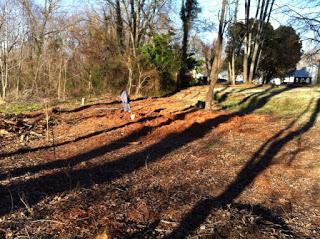
Clearing the backyard - February 2013

Planting iris on mounds in the backyard - October 2014
After spending much of 2013 preparing Chris’ vegetable beds in the backyard, Heather wanted to try changing the shape of the iris beds along the driveway to improve drainage. Heather dug all of her irises, amended the clay with more “flower and vegetable garden soil,” and adjusted the slope of the bed so that heavy rainfall would drain away from the irises (and the foundation of the house). Also in 2014, Heather tried forming mounds of soil 2 feet in diameter and 4 inches tall in the backyard, planting each with 3 rhizomes of the same variety. This time around, all irises grew and increased well. These early experiments taught Heather her own lessons about growing irises in the Piedmont. In clay with poor drainage, Heather amends her soil generously with organic material. If clay needs better drainage, she recommends planting irises in sloped beds or on mounds about 4 inches high. In locations with heavy rainfall, gardeners should avoid applying mulch in bearded iris beds.

Reblooming iris ‘Peggy Sue’ (Lauer, 2006) planted in a sloped iris bed near a warm brick wall - December 2015
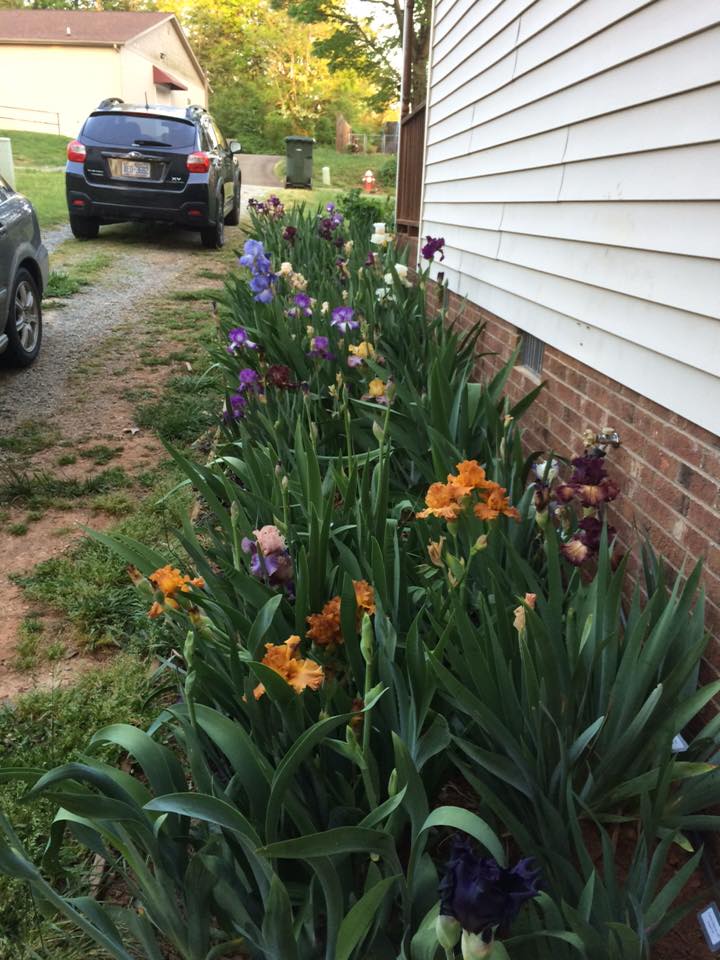
Irises in the sloped bed near driveway in peak bloom - April 2016
In the years that followed, Heather’s iris collection continued to expand and space for Chris to grow his vegetables got harder to come by. In desperation, Chris told Heather “You can grow as many irises as you want if you can make them pay for themselves.” He didn’t expect Heather would actually try doing this, let alone be successful. However, his idea to grow all iris she wanted got stuck in her head. Heather tested distribution methods, and tried potting up increases to see how much care they would require. Heather and Chris also experimented with planting irises like a row crop. They planted irises on ridges of long, narrow mounds. Instead of buying “garden soil” amendments by the bag, truckloads of leaf compost arrived from an independent garden center that made it themselves. Chris experimented with using a flame weeder* between rows instead of mulch. More iris rhizomes were grown successfully, more iris varieties were increasing well, and there were fewer weeds to pull. However, Chris and Heather faced a new problem. Growing additional iris varieties would require more space in full sun. Although it was tempting, they decided against digging up their front lawn and converting the space to irises, as many have been known to do. They started imagining a yard big enough for fruit trees, greenhouses, irises, AND vegetables.*Note that the propane-fueled flame weeder can be used only on windless days and in wet regions.

Chris incorporating a 3-inch layer of leaf compost - August 2017
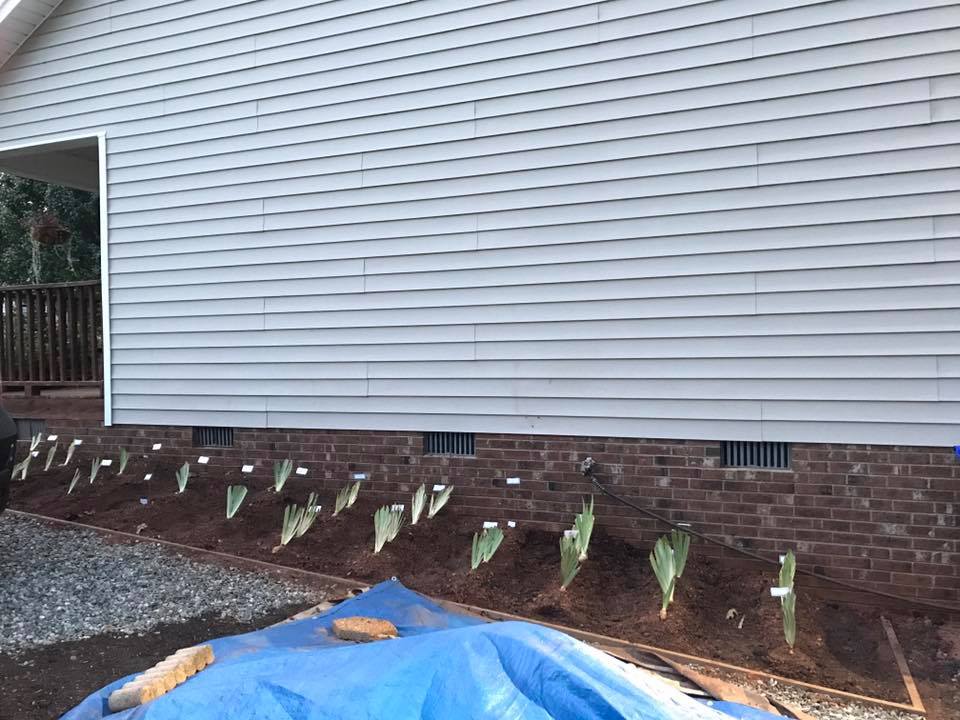
Iris planted on ridges in the driveway - August 2017
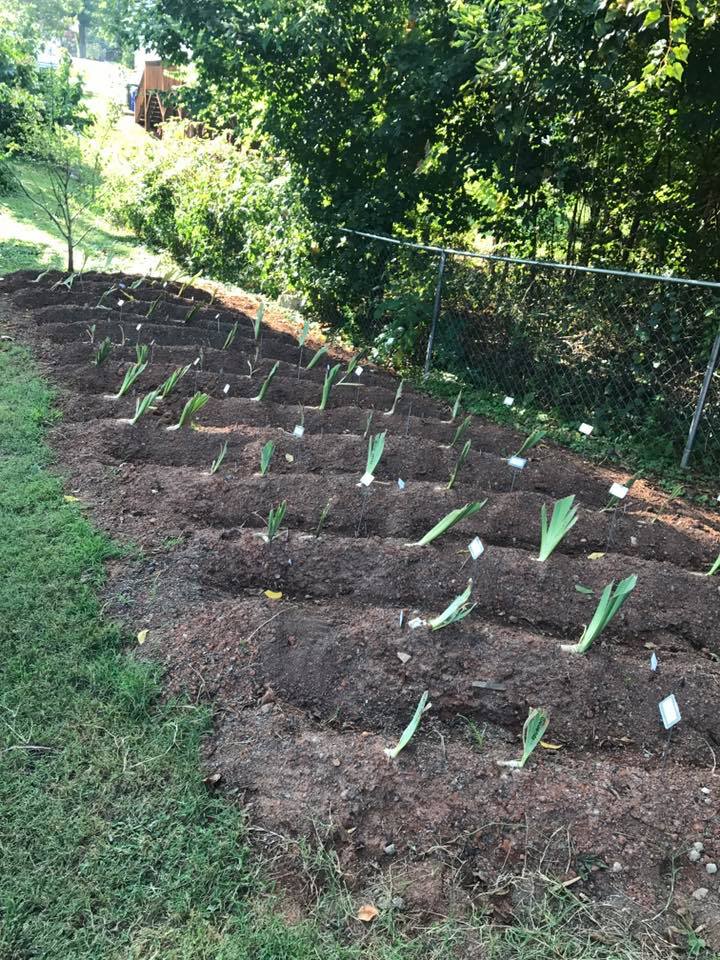
Iris planted on ridges in the backyard - August 2017

An early experiment with potted irises - April 2018
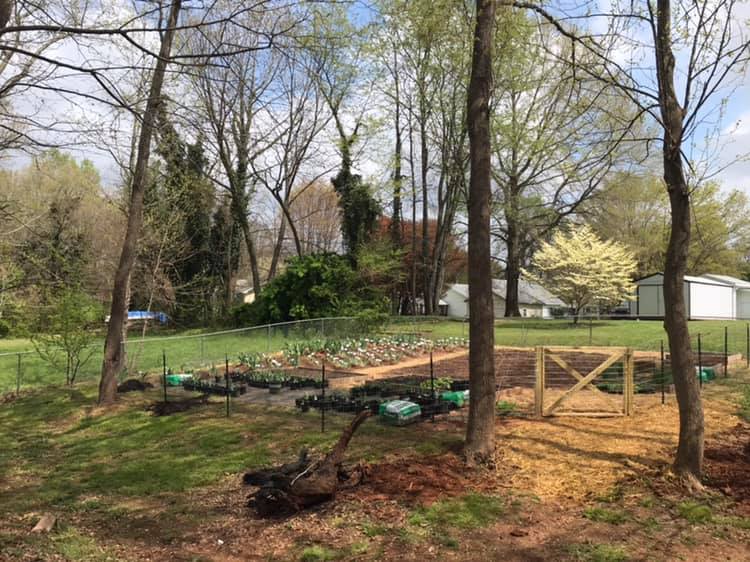
Irises in pots and rows surrounding Chris’ vegetable beds - April 2019
In 2019, Heather enrolled and completed North Carolina Farm School; a business course for small and beginning farmers offered by NC State Extension. A pair of small-scale market tests provided evidence that Heather’s business plan had potential and that preserving her family’s iris collection could pay for itself. Heather and Chris had also come to appreciate their families’ agricultural roots, and they wanted to try preserving an old farmhouse. Halfway through 2019, Heather and Chris purchased a 100-year-old restored farmhouse on 7 acres in rural North Carolina. The former tobacco farm has suitable, well-drained soil and is now home to “Broley Homestead and Iris Farm.” [Broley is a mashup of the couple’s last names, Broberg and Haley.]

Heather with potted irises during a small-scale test - April 2019
The family iris collection spent a year growing and increasing in 3-gallon pots. Meanwhile, Chris and Heather cleared land and established iris production beds. Soil at the farm contains less clay; and now they add leaf compost by the dump truck-load to improve soil texture, increase drainage, and add organic matter. In the summer of 2020, iris beds in the production field were formed using a tractor with a garden bedder attachment. They are about 6 inches tall, 30 inches across, and 150 feet long. Heather is currently experimenting with pre-emergent herbicides and Chris continues using a flame weeder* between iris rows.
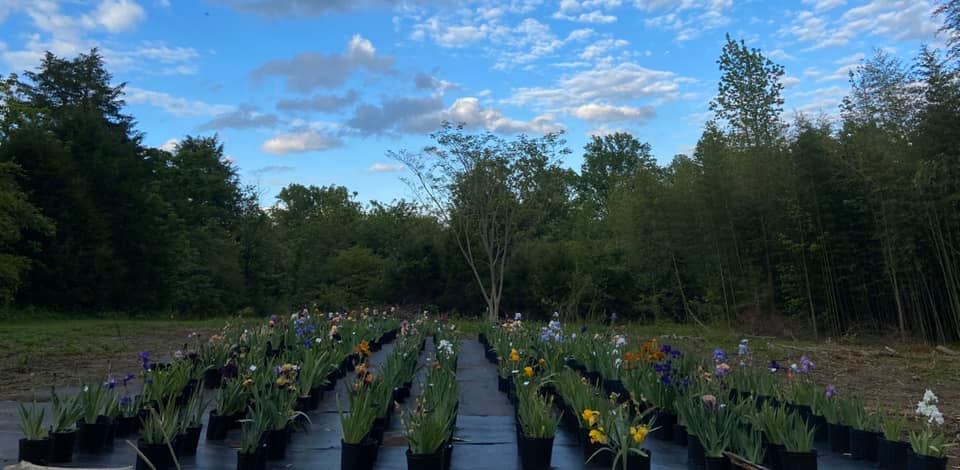
Potted Iris at the Broley Homestead - April 2020

Tractor Max with garden bedder attachment - August 2020

Tractor Max helping apply leaf compost to production beds. - August 2020

Chris watering recently planted irises in raised production beds - September 2020
Also in 2020, Alleah sold her home in California and relocated to North Carolina. She now lives about 20 minutes from Heather and Chris’ farm. Most of the varieties from Alleah’s collection are now growing on the farm, and she goes there frequently to lend a hand. With strategic purchases and donations from iris friends, the family collection now numbers about 700 varieties. Although forming iris beds on a production scale has required new techniques and equipment, the principles we learned early on remain equally useful today: Bearded irises grow best in full sun with well-drained soil.
For Comments:
What advice do you have for others growing iris and how did you learn it?
What iris topics would you like to read about in a future post?









